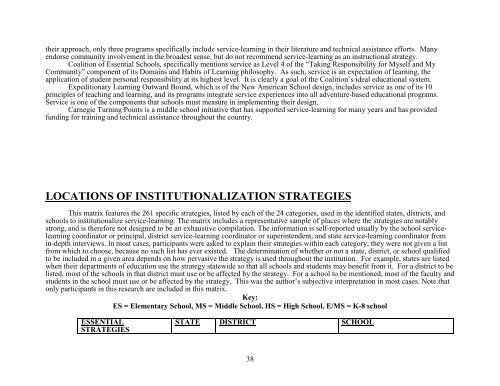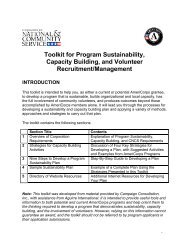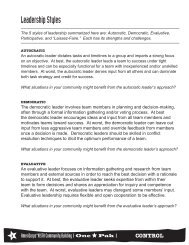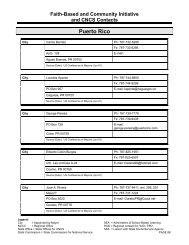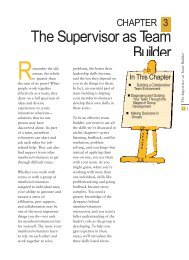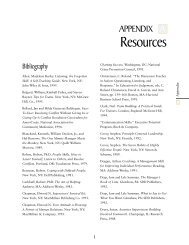MAKE IT LAST FOREVER: THE ... - National Service Resource Center
MAKE IT LAST FOREVER: THE ... - National Service Resource Center
MAKE IT LAST FOREVER: THE ... - National Service Resource Center
You also want an ePaper? Increase the reach of your titles
YUMPU automatically turns print PDFs into web optimized ePapers that Google loves.
their approach, only three programs specifically include service-learning in their literature and technical assistance efforts. Many<br />
endorse community involvement in the broadest sense, but do not recommend service-learning as an instructional strategy.<br />
Coalition of Essential Schools, specifically mentions service as Level 4 of the “Taking Responsibility for Myself and My<br />
Community” component of its Domains and Habits of Learning philosophy. As such, service is an expectation of learning, the<br />
application of student personal responsibility at its highest level. It is clearly a goal of the Coalition’s ideal educational system.<br />
Expeditionary Learning Outward Bound, which is of the New American School design, includes service as one of its 10<br />
principles of teaching and learning, and its programs integrate service experiences into all adventure-based educational programs.<br />
<strong>Service</strong> is one of the components that schools must measure in implementing their design.<br />
Carnegie Turning Points is a middle school initiative that has supported service-learning for many years and has provided<br />
funding for training and technical assistance throughout the country.<br />
LOCATIONS OF INST<strong>IT</strong>UTIONALIZATION STRATEGIES<br />
This matrix features the 261 specific strategies, listed by each of the 24 categories, used in the identified states, districts, and<br />
schools to institutionalize service-learning. The matrix includes a representative sample of places where the strategies are notably<br />
strong, and is therefore not designed to be an exhaustive compilation. The information is self-reported usually by the school servicelearning<br />
coordinator or principal, district service-learning coordinator or superintendent, and state service-learning coordinator from<br />
in-depth interviews. In most cases, participants were asked to explain their strategies within each category; they were not given a list<br />
from which to choose, because no such list has ever existed. The determination of whether or not a state, district, or school qualified<br />
to be included in a given area depends on how pervasive the strategy is used throughout the institution. For example, states are listed<br />
when their departments of education use the strategy statewide so that all schools and students may benefit from it. For a district to be<br />
listed, most of the schools in that district must use or be affected by the strategy. For a school to be mentioned, most of the faculty and<br />
students in the school must use or be affected by the strategy. This was the author’s subjective interpretation in most cases. Note that<br />
only participants in this research are included in this matrix.<br />
Key:<br />
ES = Elementary School, MS = Middle School, HS = High School, E/MS = K-8 school<br />
ESSENTIAL<br />
STRATEGIES<br />
STATE DISTRICT SCHOOL<br />
38


